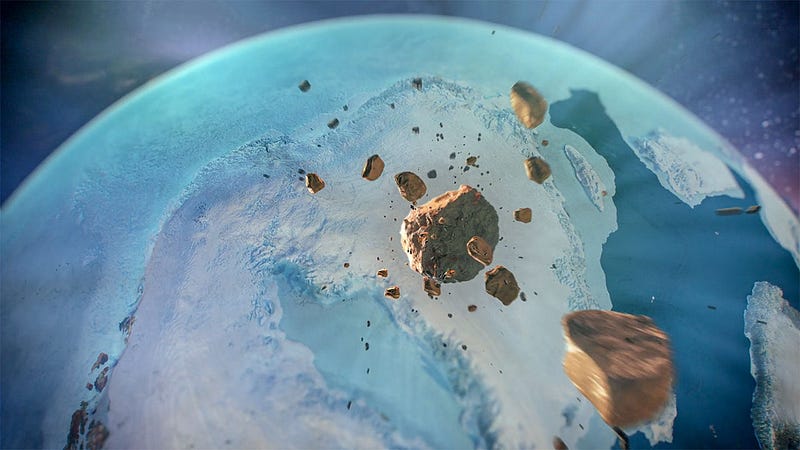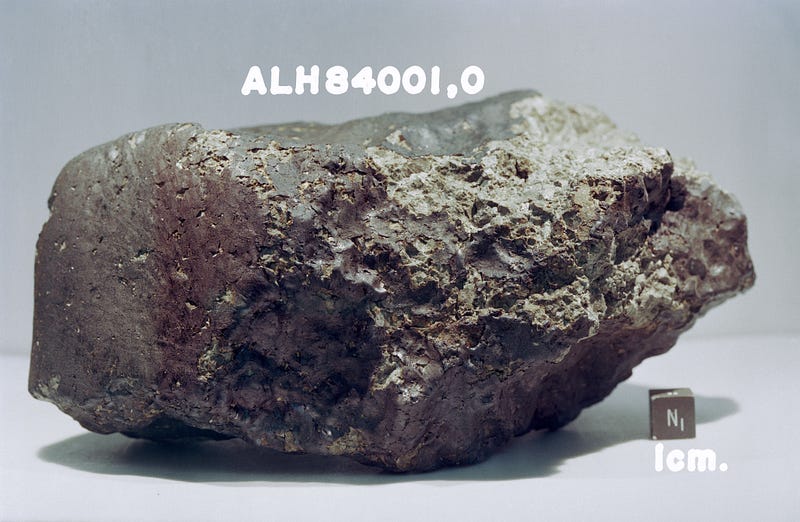Unveiling ALH84001: The Meteorite That Sparked Alien Life Theories
Written on
Chapter 1: The Discovery of ALH84001
In December 1984, researchers braved the harsh, icy expanse of Antarctica, where the ground shimmered under the sun and the winds sculpted the landscape into rippling patterns. Despite its beauty, the cold seeped into their gear, making the environment unforgiving. However, these conditions are ideal for uncovering meteorites, which lie preserved in ancient blue ice, exposed by erosion from relentless winds.
During this expedition, scientists discovered a meteorite in the Allan Hills region. Weighing nearly 5 pounds (2 kg), it bore a distinctive fusion crust—a glassy texture formed as it traversed the Earth's atmosphere. This Martian rock has been preserved in frigid temperatures for approximately 13,000 years. Some researchers believe its interior has a greenish hue, although it appears duller in laboratory settings. Dating it reveals that ALH84001 is about 4.5 billion years old, with cracks indicative of damage from an impact event around 4 billion years ago. This collision sent the fragment into space, where it traveled for 13–16 million years before landing on Earth, marking the start of its remarkable journey.

Chapter 2: Intriguing Evidence of Life
Earth benefits from its atmosphere, which protects it from incoming space debris by incinerating it before it can reach the surface. In contrast, Mars, with its thin atmosphere, is more vulnerable to impacts. The cracks within ALH84001 revealed granules of calcium carbonate, formed when mineral-rich water interacts with carbon dioxide. These granules not only suggested the historical presence of water on Mars but also resembled those produced by bacteria on Earth.
Upon examining the granules under an electron microscope, researchers observed structures akin to bacterial chains, surrounded by membranes—similar to those found in Earth's magnetite-producing bacteria. The magnetite crystals, vital for bacterial navigation using geomagnetic fields, are typically products of biological processes. NASA biologists assert that the magnetite found in ALH84001 is consistent with this notion, residing within carbonate minerals dated at 3.9 billion years old—further supporting the possibility of extraterrestrial life.
The first video titled "Signs of life in a meteorite from Mars? The real story of ALH84001 and new data" delves into the history and implications of this remarkable meteorite.
Despite Mars not currently providing suitable conditions for magnetite production, evidence suggests that the planet once had liquid oceans and a magnetic field. However, some scientists challenge the assertion that magnetite is exclusively a product of biological activity, arguing instead for potential abiotic processes that could explain its formation. This theory posits that a thermal event could have created the magnetite, though this would require precise cooling conditions to avoid uniformity or imperfections.

Chapter 3: The Debate Continues
The largest fossils within ALH84001 were significantly smaller than the smallest known bacteria, leading to speculation that the "life signatures" within the meteorite could stem from nanobacteria, which may lack sufficient DNA for replication. Moreover, the characteristics of alien life might not conform to Earth-based biological frameworks. Some argue that the fossil-like shapes observed could simply be artifacts from electron microscopy rather than indicators of life.
The second video titled "The Case of ALH84001" explores various theories surrounding the potential of extraterrestrial life within the meteorite.
The organization of structures within ALH84001 raises intriguing questions. Organization is a hallmark of living entities, challenging the tendency of the universe towards disorder, as described by thermodynamic laws. The elongated forms within the meteorite suggest a resemblance to life, yet they lack evidence of reproduction or growth stages, remaining silent and ordered.
While there are nine other Martian meteorites containing carbon, researchers assert that these samples are not contaminated by Earthly materials nor are they products of biological processes. Instead, they resulted from volcanic activity on Mars. Nevertheless, the vision of an ancient Mars, once bathed in oceans, continues to captivate imaginations—hinting at the possibility that life once flourished in its waters.
In a speech over a decade after the meteorite's discovery, President Clinton remarked on its significance, suggesting it connects us across vast distances and time. Despite the absence of scientific consensus, the meteorite remains a powerful symbol of the possibility of life beyond our planet, a notion that continues to inspire curiosity and exploration.